
Continuous Glucose Monitoring (CGM)
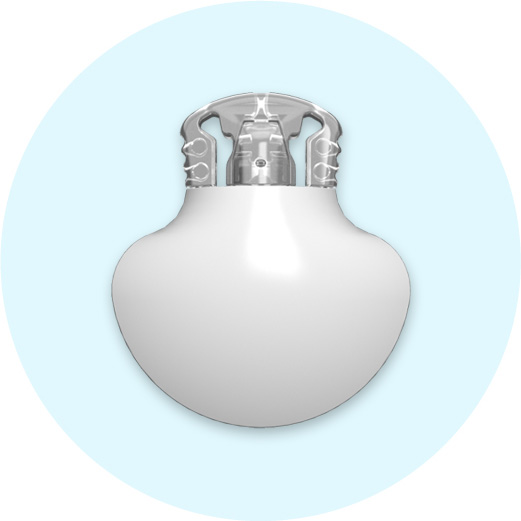
Is Continuous Glucose Monitoring (CGM) for you?
Continuous Glucose Monitoring (CGM) can be especially beneficial for certain people. Have a look at this checklist to determine whether CGM could be beneficial for you or your child.
- You aren't meeting your time in range or A1c goal1,2
- You have frequent low glucose levels
- You are unaware of your low blood sugars
- You want to reduce your A1c targets without increasing hypoglycaemic events (low blood glucose)
- You have widely variable blood sugar levels
Keep reading to find out more about the benefits of CGM.
Monitoring blood glucose
Glucose monitoring is an essential part of self-care for people with T1D.3 There are different ways to monitor glucose levels, including self-monitoring CGM.
CGM
CGM gives you a complete picture of your glucose levels, which can lead to better glucose control and help you make lifestyle decisions more easily.1

What is CGM?
CGM is a way for people living with diabetes to check glucose levels in real-time or monitor glucose levels over a period of time. A CGM is a small, wearable device that continuously measures glucose levels and provides trends and patterns throughout the day and night. It relies on interstitial fluid (that is, fluid from the body that surrounds blood vessels and cells), rather than blood samples to provide measurements.3
By using a continuous glucose monitor, your CGM system will automatically receive glucose levels every 5 minutes allowing you to fingerstick less often. CGM can be used with or without an insulin pump.*
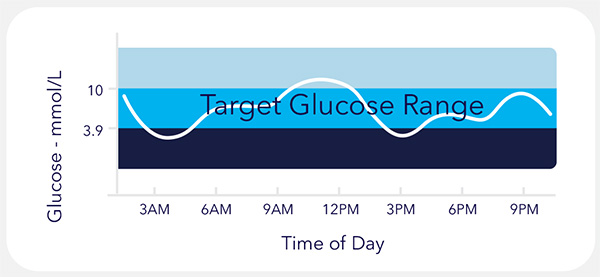
What is time in range?
Time in range tracks how much time you spend in your target range of blood glucose - normally 3.9 - 10.0 mmol/L4
Unlike HbA1c, time in range is more reflective of how you feel each day and the ups and downs rather than the average of these, which can often be misleading.4 The more time you spend in range, the lower your HbA1c drops.5
Self-monitoring (via blood glucose meter) |
CGMs |
| Only provides a brief “snapshot” of glucose levels at a single moment in time. | Gives a greater view of glucose trends. |
| Requires people to check their glucose at crucial points during the day. | Provides valuable information at crucial points during the day, so people don't have to remember to check their glucose. |
| Requires frequent fingerstick checks. | Reduces the need for fingerstick checks. |
Benefits of CGM
CGM insights, notifications and visibility
Early notification of oncoming lows and highs, day and night.
Visibility of time spent high, low, and within a healthy glucose range of 3.9 - 10 mmol/L.
Insights into the direction your glucose levels are going.
Insights into how food, physical activity, medication and illness impacts your diabetes^.
*If you are less than 24 years old and your HbA1c goal is 7.5%, you should aim for 60% time in range.
†Guardian™ Sensor 3 Performance for the MiniMed™ 670G insulin Pump. Sensor calibrated every 12 hours; within 30 minutes of event, both Low Threshold and Low Predictive alerts ON; with 41.7% false alert rate if the patient is unable to respond to the Suspend on Low alarm.
^The system is intended to complement, not replace, information obtained from standard blood glucose monitoring devices. All therapy adjustments should be based on measurements obtained from standard blood glucose monitoring devices and not on values provided by the system.CGM options to fit your lifestyle
Whether you manage your diabetes with a pump, multiple daily injections, oral medications or through diet and exercise, Medtronic offers CGM products and insulin pump systems that give you, your loved ones and healthcare professionals the insights to track and manage your diabetes on your terms.
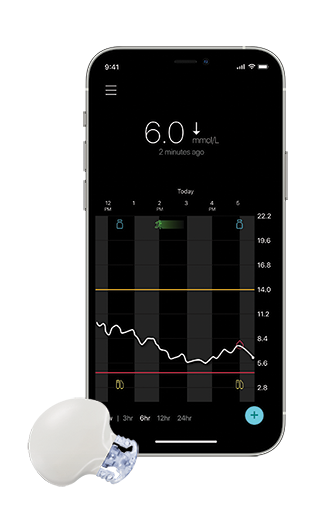
Guardian™ 4 System
The GuardianTM 4 System offers you the opportunity to manage your diabetes with less burden than is associated with fingersticks.
- Predicts lows and highs up to 60-minutes in advance.
- The App has customisable alert volumes and in-app training and resources. Compatible with iOS and Android devices.
- No fingersticks required
- 288 glucose readings per day without fingersticks*. Calibrations optional.
Learn more
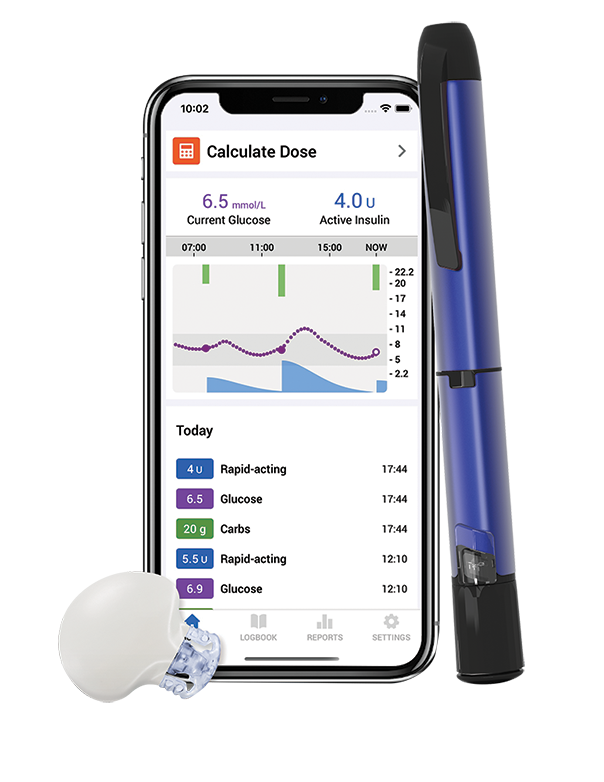
Smart MDI System
The Medtronic Smart MDI system includes InPen™ and Guardian™ 4 Sensor, with features that allow you to stay ahead of your glucose levels.
- Real time CGM with predictive glucose alerts
- Records glucose levels every 5 minutes, 24/7 with no fingersticks*
- Alerts of lows and highs up to 60 minutes ahead of time with no fingersticks*
- Personalised insulin dosing
- Insulin tracking
- Dose calculator
- Dose reminder
Learn more CGM and InPen apps features
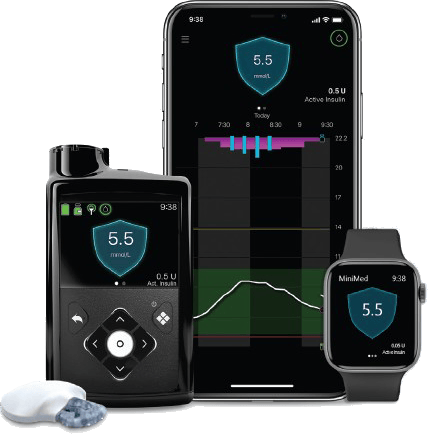
MiniMed™ 780G System + Guardian 4 Sensor
The only system available that automatically adjusts and corrects every 5 minutes, so you don't have to.
The MiniMed™ 780G system^ with Guardian™ 4 Sensor consists of an insulin pump, a CGM system, SmartGuard™ technology, diabetes management software, a smart device smartphone display app, a blood glucose meter, and infusion set.
Learn more
Talk to a diabetes therapy consultant about CGM today.
Request a call today to discuss the benefits of CGM with a Medtronic Diabetes Therapy Consultant.
*If CGM readings do not match symptoms or expectations, use a blood glucose meter to make diabetes
treatment decisions. Refer to System User Guide.
^Components sold separately.
ALWAYS FOLLOW THE DIRECTIONS FOR USE.
For detailed information regarding indications, contraindications, warnings, precautions, and
potential adverse effects, please consult the information for use at:
www.medtronic-diabetes.com.au Support > Guide &
Manuals
The MiniMed 780™ insulin pump is indicated for use by patients age 7-80 years with Type 1 diabetes, whose total daily dose of insulin is 8 units per day or more. The Guardian™ 4 Sensor is intended for insertion into persons ages 7 years and older. InPen™ is intended for single-patient use by people with diabetes for the self-injection of a desired dose of insulin. A healthcare professional should assist in programming of the device prior to use, based on various patient-specific criteria and targets. For additional product and safety information, please consult the Instructions for Use.
References:
1. Bergenstal RM, et al. JAMA 2016; 316:1407-1408.
2. Stone, 2018. Retrospective Analysis of CareLink (670G).
3. Diabetes Australia Position Statement. Glucose self-monitoring in adults with type 1 diabetes or
type 2 diabetes. 2017. Available from:
https://www.diabetesaustralia.com.au/wp-content/uploads/Glucose-position-statement-2017.pdf
[Accesses April 2023].
4. IQVIA Institute for Human Data Science. Advancing Glycemic management in people with diabetes.
October 2019.
5. Vigersky RA and McMahon C. Diabetes Technol Ther. 2019;21(2):81-85.
6. Battelino T et al. Diab Care. 2019;42(8):1593-1603.
7. Beck R. JAMA. 2017;317(4):371-378.
